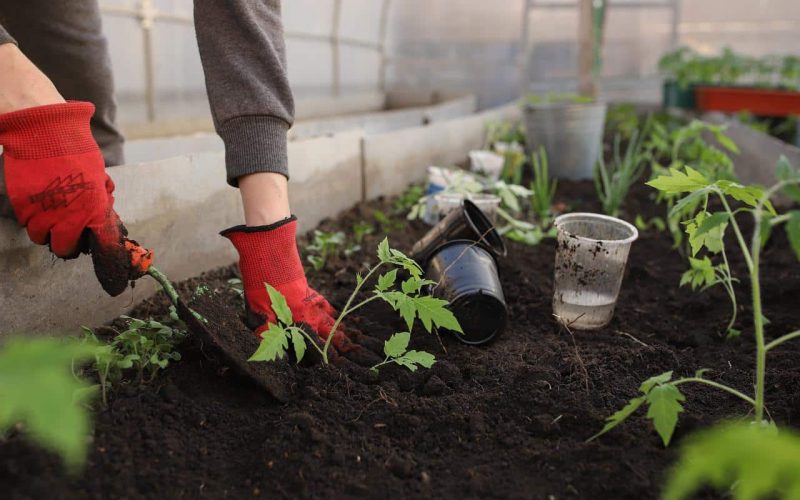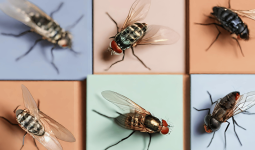Finding the perfect fencing option can be tricky, especially if you have specific goals. Do you want something aesthetically pleasing? Something environmentally friendly? Something cheap?
This list of 9 incredibly useful vegetable garden fence ideas will help you find an option perfect for your needs.
This also includes some DIY fences and helpful tips from gardening experts. Don’t waste any more time looking; start building today!
1. Use White Lattice
Do you love the look of a traditional white picket fence? If so, you’ll love this white lattice fence idea. This type of fence is also perfect for vegetable garden fence ideas.
Because it’s tall enough to keep animals out but still allows plenty of light and air to reach your plants. Plus, the lattice top provides a bit of extra decoration.
Therefore, these are ideas to try. First, attach a few yards of white lattice to some posts with wire fencing brackets.
The result will be a very attractive, inexpensive fence that can serve as an outdoor trellis for climbing plants.
2. Use Wrought Iron Metal Fencing
Wrought iron metal fencing is an excellent option for vegetable garden fence ideas because it’s strong and durable. It’s also easy to install and can be customized to fit your specific needs. If you’re looking for extra protection, you can always add wire mesh to the fence.
However, these are ideas to try for using wrought iron metal fencing. First, install gates with hinges on either side of the fence to swing both ways. Add privacy screening by planting bamboo or vines on the fencing (or in front).
Moreover, two layers of fencing should be used: a bottom layer at waist height and a top layer at head height. That is to make climbing more difficult.
Also, install chicken wire along the inside edge so weeds can’t grow between the bars. Then, fill in with gravel for drainage.
3. Use Hardware Cloth To Make Sturdy And Secure Fences
You can use hardware cloth to make sturdy and secure fences for your vegetable garden. This fencing is made from woven wire coated with plastic or vinyl.
However, it is available in various widths and heights to suit your needs. You can also choose from various colors to match your garden’s décor. Hardware cloth is easy to install and will last for years with proper care.
4. Use Interlocking Wooden Slats To Make A Decorative Fence
Decide on the height, width, and overall look of your vegetable garden fence ideas. Interlocking wooden slats is a great way to add privacy and decoration to your garden. They come in various colors and can be easily customized to fit your space.
However, to install, hammer the slats into the ground using a mallet or screw them into existing fence posts.
If you’re looking for extra protection for your garden, consider adding a wire mesh underneath the slats. This will keep out small animals and pests while allowing air and light to reach your plants.
5. Create An Inexpensive Privacy Screen With Bamboo Canes And Bamboo Stakes
Bamboo canes and stakes are great options for an inexpensive way to create a privacy screen for your vegetable garden.
Bamboo is light and easy to work with, making it a great material for fence building. It is also eco-friendly and will add a natural touch to your garden.
However, here’s how to create a privacy screen with bamboo canes and stakes. First, lay the bamboo stakes on the ground as your desired boundary.
Cut down long sections of bamboo canes (not too short), then place one end of each cane over a stake.
Also, Bend the cane so it rests at an angle across two adjacent stakes. Finally, another cane was laid similarly on top of the first.
Nevertheless, they should cross at right angles (creating a T shape). Repeat this process until you’ve covered all sides of your boundary with overlapping pieces of bent bamboo canes.
6. Grow Berry Bushes Along The Edges Of Your Fence
Berry bushes are not only beautiful, but they also provide delicious and nutritious fruit for you and your family. Growing them along the edges of your fence will give you easy access to fresh berries all season long.
Plus, the extra height the fence provides will protect the delicate bushes from hungry animals. Another great idea is to grow sunflowers! They look fantastic, but their blooms attract different types of birds that will help pollinate your garden.
Plus, after the flowers have died off, the seeds can be harvested and used as a nutritious addition to any dish. If you want more color in your yard, consider planting colorful flowers in front of your vegetable garden fence ideas. They come in all shapes and sizes, so there’s sure to be something that exactly matches your preferences!
7. Create An Attractive Trellis In Front Of Your Raised Bed Vegetable Beds.
A trellis is the perfect solution if you’re looking for a simple and attractive way to keep your garden tidy. It will not only add a touch of decoration to your yard but also keep your plants from sprawling. Plus, it’s easy to build!
However, here’s how to create a freestanding raised bed that doubles as an effective trellis. First, dig out four large holes in the ground and fill them with dirt.
Next, position two pieces of untreated lumber perpendicular to each other in one hole so that they are upright on either side. Cover this with three inches of soil before inserting another piece of lumber (the same height) into the second hole.
Repeat this process until both sides are completed. Therefore, fill the area between them with more soil until they are even with one another. You can also top them off with mulch if desired!
8. Plant Thick, Thorny Vines Like Roses Or Blackberries For An Effective Natural Hedge
Planting a thorny vine like a rose or blackberry is an effective way to create a natural hedge. Not only will it deter animals from entering your garden, but it will also add some aesthetic appeal. Plus, it’s a relatively easy way to get started with fencing.
However, here are some tips to get you started. First, make sure the plants you choose can tolerate the harsh sun and soil that often accompanies vegetable gardens. Find out if the plant can be grown in a container before investing in pots and fertilizers.
Therefore, consider whether this gardening style would suit your climate, as certain plants require cooler climates to thrive.
Study how long each plant grows and what type of soil they need. Be patient! Most plants take around three years to reach maturity.
9. Picket Fence
A picket fence is a classic choice for vegetable garden fence ideas. It is easy to build and can be made from various materials, such as wood, metal, or PVC. Plus, it looks great!
However, here are a few things to remember when choosing a picket fence for your vegetable garden fence ideas.
The pickets’ width should be twice as wide as their height (to provide maximum privacy). The spacing between each row should be 12 inches (to make it easier to grab weeds).
Also, the space between posts should measure 24 inches (so you have enough room to plant between them). Posts should be at least 6 feet tall. If you use wooden posts, use pressure-treated lumber so they won’t rot over time.
Therefore, if using metal posts, ensure they’re galvanized so they won’t rust over time. Wood pickets are often painted white to deter pests, and steel pickets are often coated with black paint or zinc oxide for the same purpose.
Moreover, black vinyl pickets are available and will not attract termites. Flimsy gates should not be used on vegetable garden fence ideas because animals will easily push through them.
Nevertheless, it’s also important to maintain good soil around the base of the posts. This will help prevent erosion from wind or water runoff and provide nutrients for nearby vegetables.
You can also Add friendly plants like nasturtiums, hollyhocks, marigolds, daylilies, foxgloves, and sunflowers along the fence line.
These bright colors are lovely accents during summer and welcome winter visitors. Birds and butterflies love these plants too!
In addition, consider planting flowers like morning glory, clematis, or wisteria close to the house. These flowers will lure beneficial insects into your yard if they grow well.
But you can add friendly plants like nasturtiums, hollyhocks, marigolds, daylilies, foxgloves, and sunflowers along the fence line. If you want to add privacy to your backyard, a fence is the way to go.
Moreover, finding the right style of fence can be tricky. We’ve compiled this list of 9 vegetable garden fence ideas to help you get started.
Conclusion
A vegetable garden fence is a great way to keep animals out and define your garden’s space. There are many different types of fences, so it’s important to pick one that will work best for your needs.
However, whether you want a simple picket fence or something more elaborate, there are plenty of options. Hopefully, this list has given you some ideas for what type of fence would work best for your vegetable garden.








